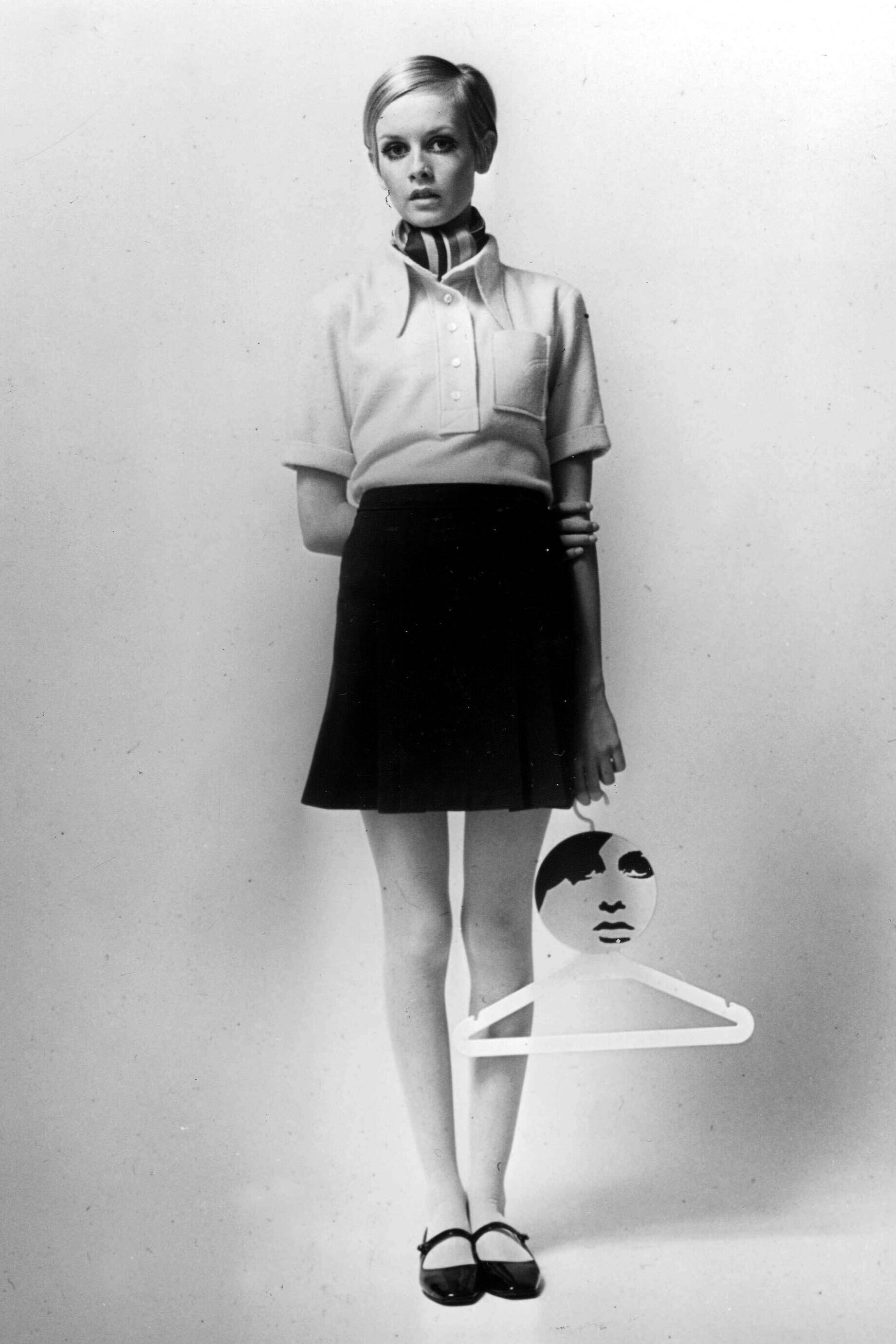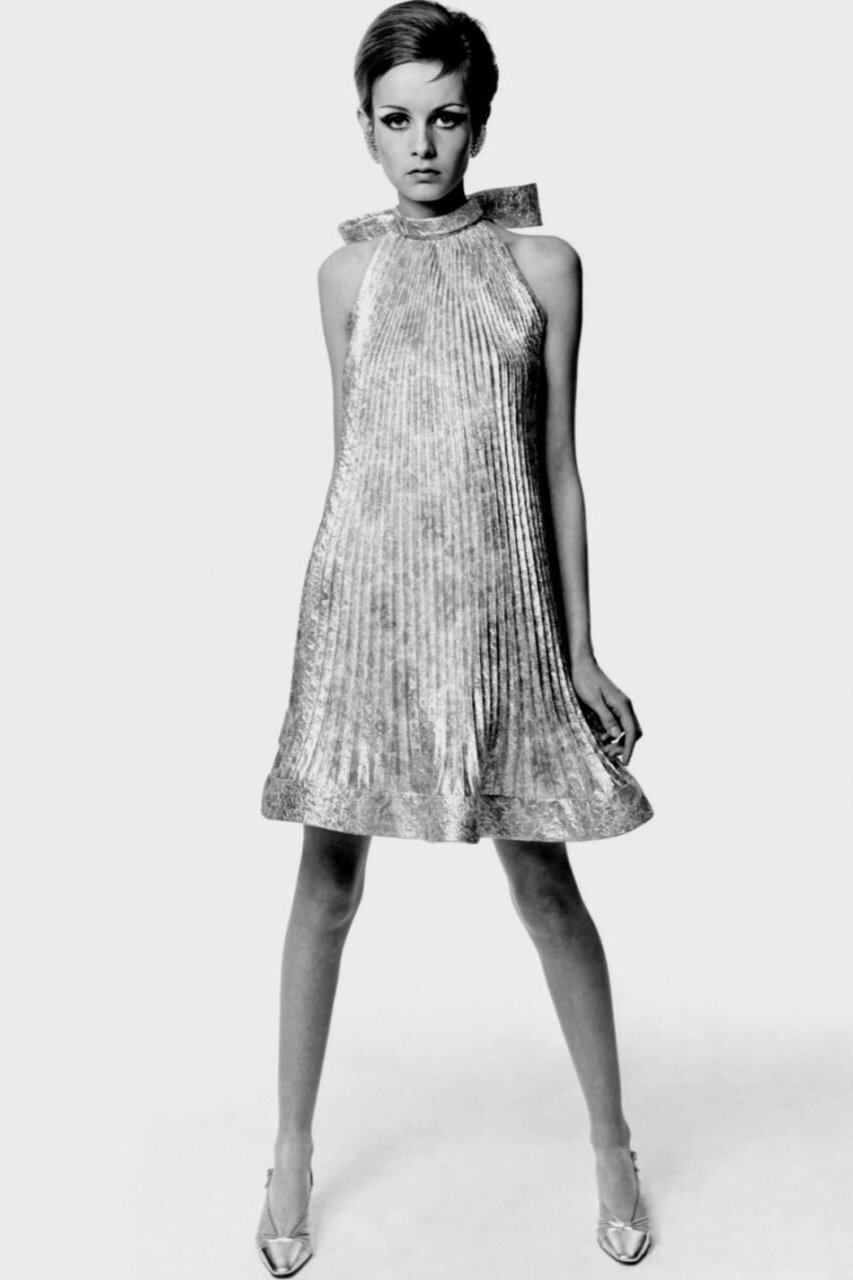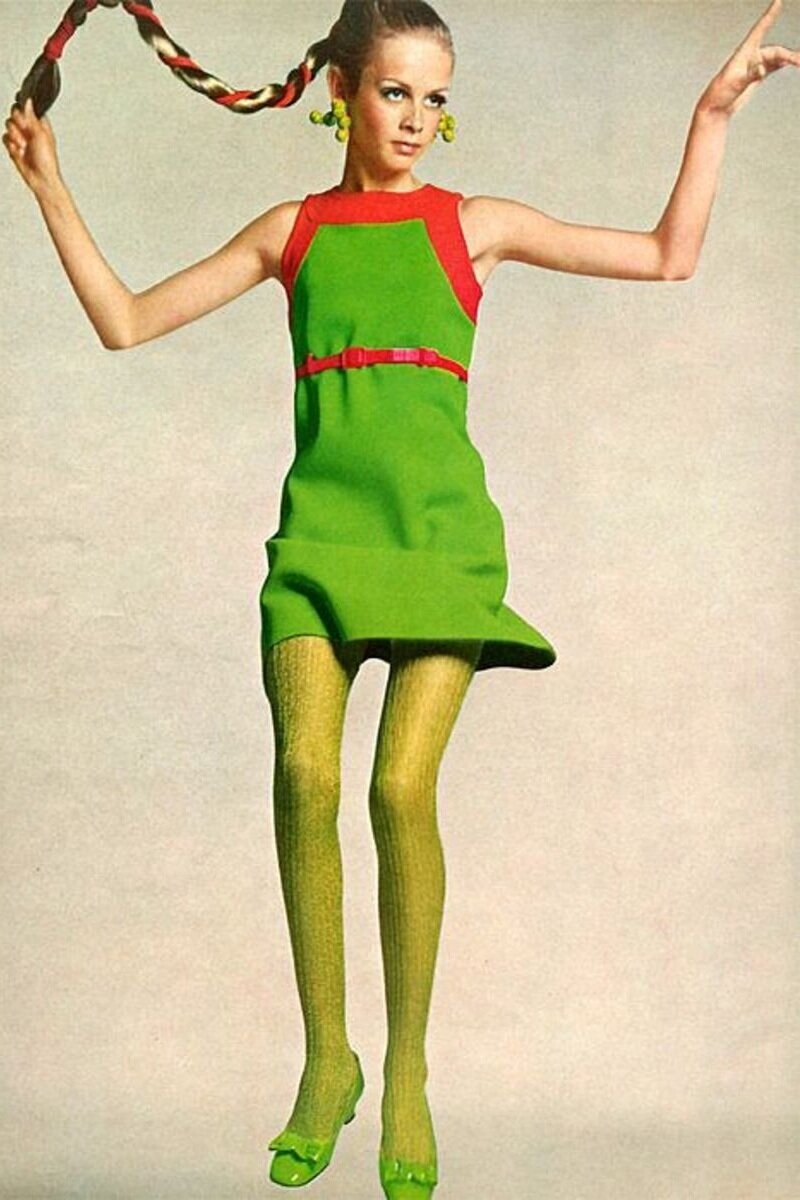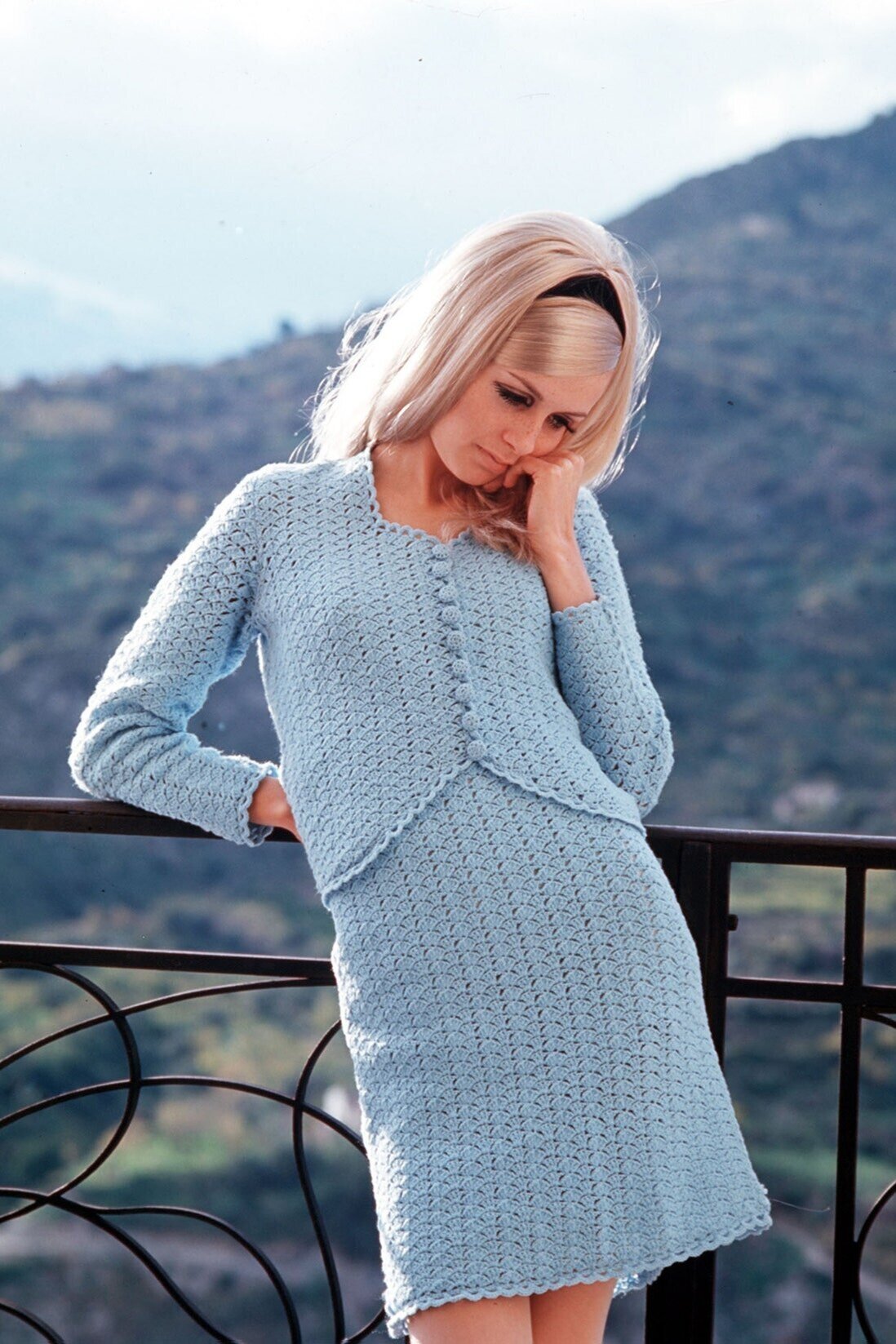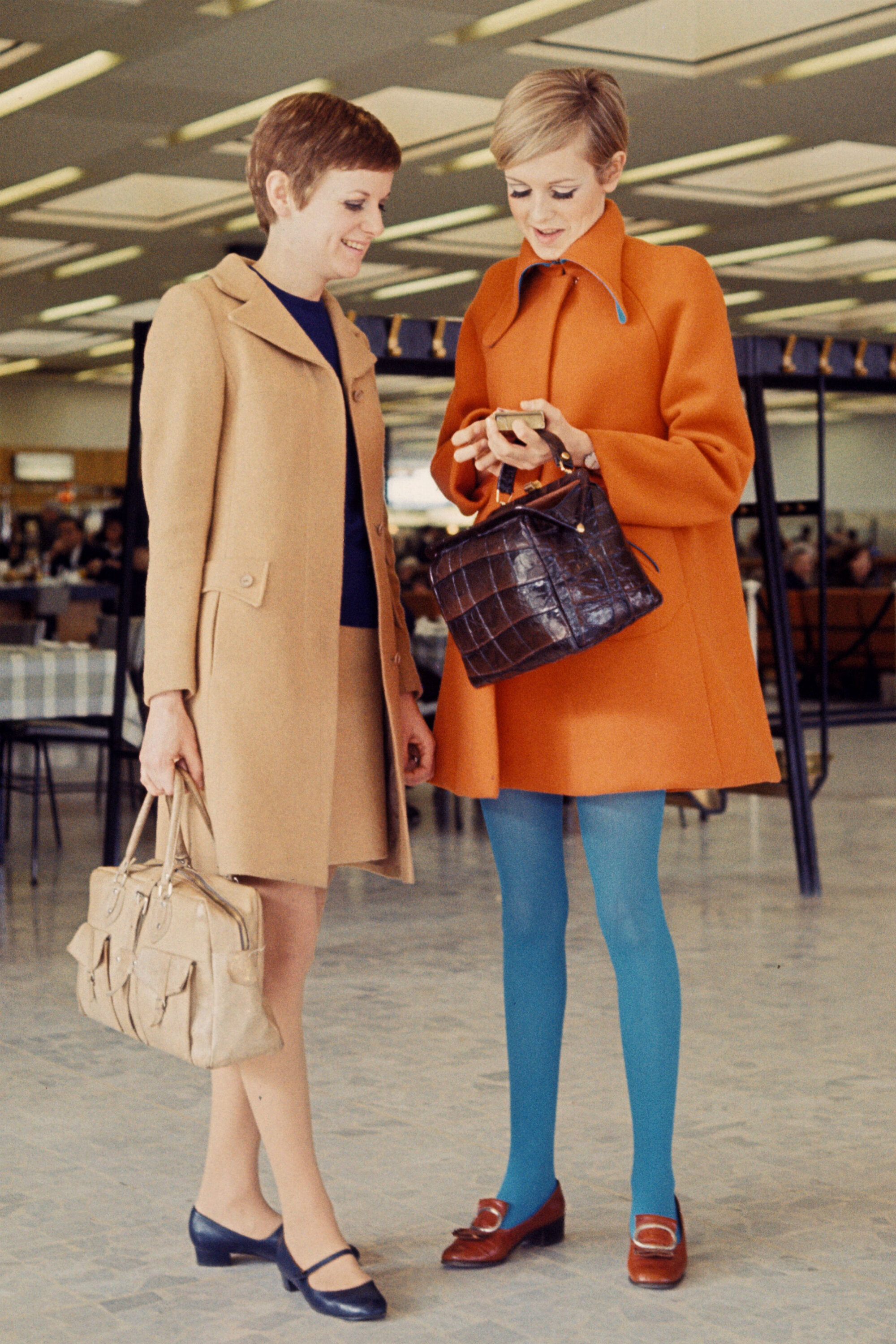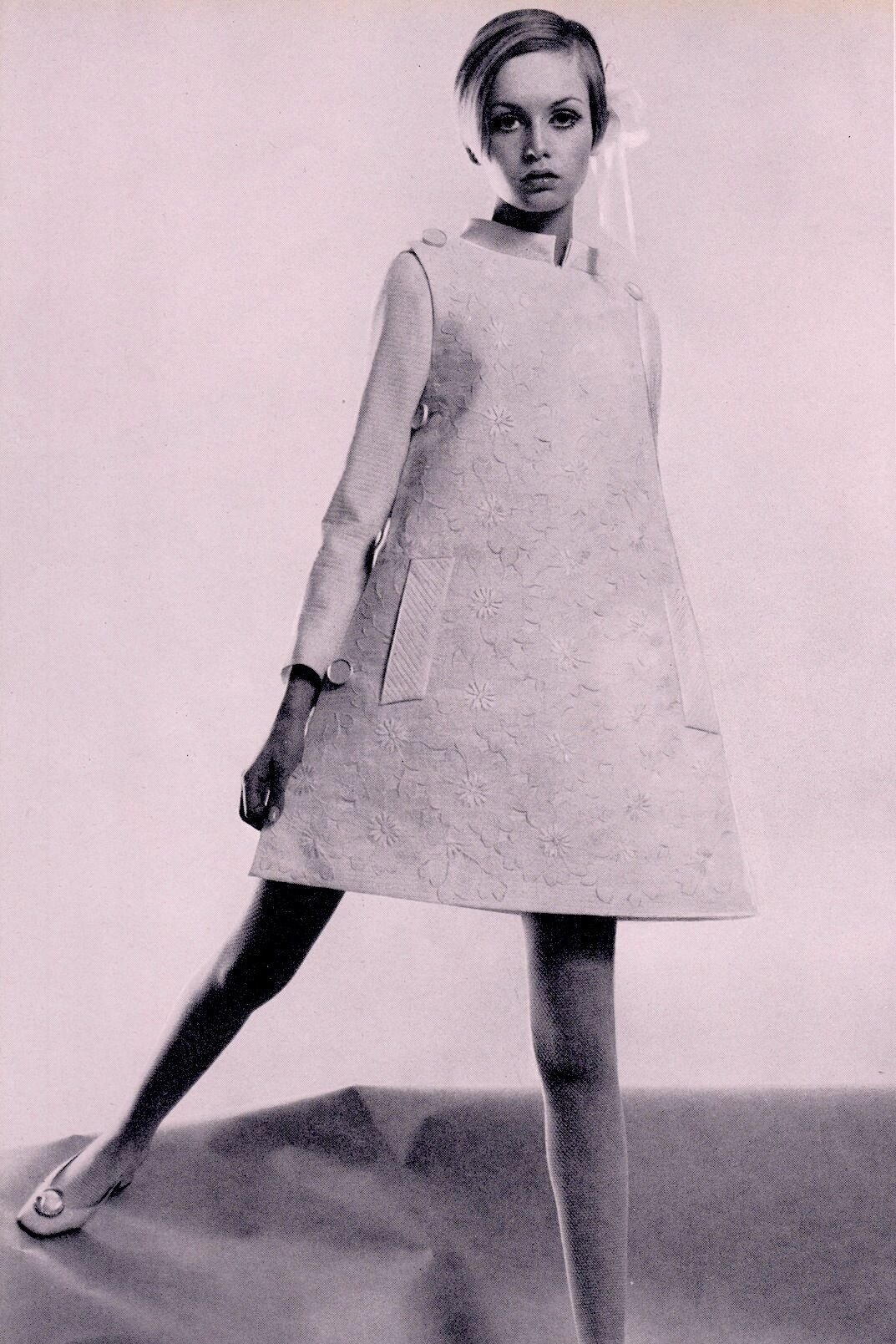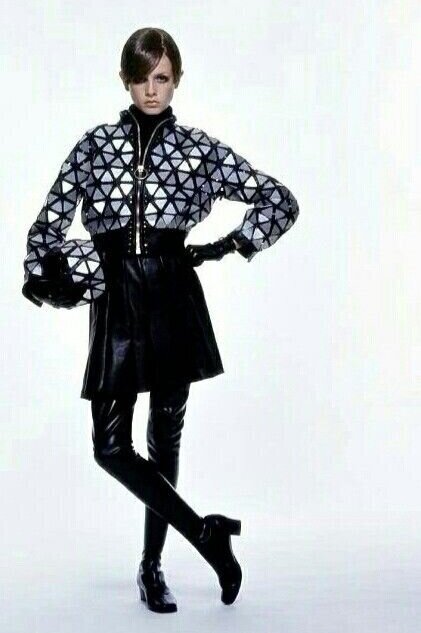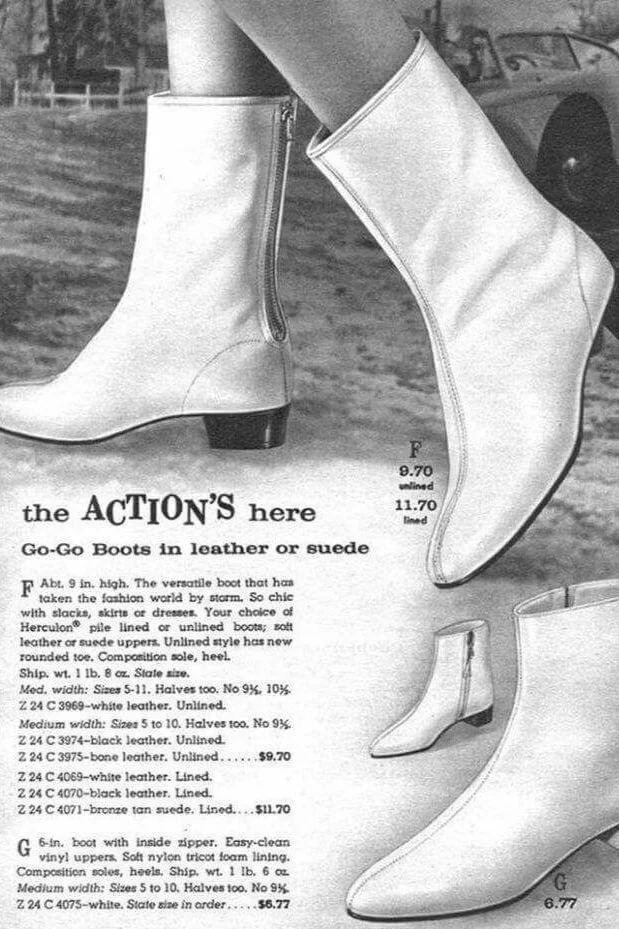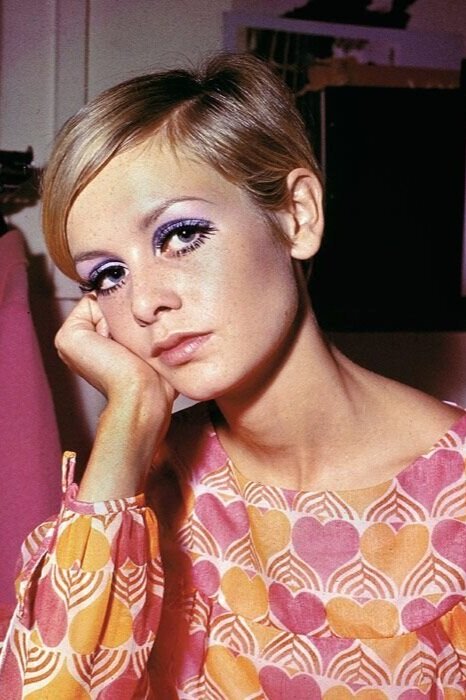Twiggy Wearing Every 60s Fashion Trend Ever
The 1960s was a pivotal decade in modern women’s fashion. From the Space Age to Woodstock hippies to the Youthquake to the British Invasion, 60s fashion trends directly correlated with social movements of the time.
During the 60s, there were four overarching trends in women’s fashion: a continuation of the ladylike styles from the previous decade, the emergence of the Youthquake movement and It-Girls like Mary Quant and Twiggy, the growing influence of technology and the Space Age, and the hippie style that came to dominate the late 60s.
While there were many notable fashion icons of the 60s (Audrey Hepburn, Jackie Kennedy, Brigitte Bardot, and Jane Birkin, just to name a few), no one personified the decade quite like British supermodel Twiggy. Her boyish pixie cut, trend-setting mod style, and infamous eyelashes made her one of the most recognizable faces of the era and paved the way for the future Kate Mosses and Linda Evangelistas of the world.
Born Lesley Hornby, Twiggy earned her nickname from her hairdresser and soon-to-be-boyfriend Nigel Davies (later known as Justin de Villeneuve), who dubbed her “Twigs” because of her waif-like frame. Unlike the bombshell blondes and glamour models of the 50s, Twiggy’s lanky body and girlish charm embodied the young, sexually liberated “Single Girl” that emerged from the feminist and youth movements of the 60s.
In 1966, de Villeneuve launched Twiggy’s career by giving her one of the most famous haircuts of all time, her iconic blonde pixie cut. She was soon declared “The Face of ’66” by The Daily Express and voted British Woman of the Year. In April 1967 she graced the cover of American Vogue, gaining international recognition and securing her status as one of the biggest influences on 1960s fashion.
Truly, no one embodied the zeitgeist (wink, wink) of 60s style quite like Twiggy. So to celebrate the pivotal decade in women’s fashion, we’ve dug through the archives and rounded up some iconic pics of Twiggy wearing the biggest 60s fashion trends.
To showcase the biggest 60s fashion trends, we’ve rounded up a few of Twiggy’s most iconic looks of the decade.
Mini Skirts
Twiggy wearing a mini skirt and Mary-Janes
Twiggy wearing a mini skirt and crochet set
Hands down, the single most important trend in 60s women’s fashion was the introduction of the mini skirt. Throughout the women’s liberation movement, the heightening of women’s hemlines directly correlated with their increasing sexual freedom. Instead of following in their mothers’ footsteps and settling down in the suburbs, young women felt empowered to increase their economic and social independence, enjoy sex before marriage, pursue fulfilling careers outside the home, and wear skirts above the knee.
Thanks to growing access to birth control and game-changing books like Sex and the Single Girl by Helen Gurley Brown and The Feminine Mystique by Betty Frieden, women no longer aimed to be wifed up by their early 20s. Instead, they sought to enjoy life as independent, single young women before settling down. Many demonstrated their newfound freedom by ditching the sophisticated housewife look of the past decade in favor of mod fashion.
Colorful school-girl-inspired mini skirts were a cornerstone of the increasingly popular mod style (short for modern style ICYMI) that emerged from London during the mid-60s. Often paired with colored tights or go-go boots, the short skirts felt far more youthful than the full circle skirts worn by older women. Mini skirts peaked in popularity mid-decade before hemlines dropped back to midi and maxi lengths during the late-60s hippie movement.
Shift Dresses
Twiggy wearing a hot pink shift dress, 1966
Twiggy wearing a Pierre Cardin dress, 1967
Like mini skirts, the popularity of shift dresses echoes the progress made during the second wave of the feminism movement. The loose fit and short hemlines of mod shift dresses allowed young women to ditch the uncomfortable girdles and restrictive undergarments their mothers had been wearing for decades. While 50s dress silhouettes like Dior’s New Look emphasized an hourglass shape, 60s dresses shifted attention away from women’s midsections and towards their legs.
At the heart of the mod fashion movement was British designer Mary Quant. As a firm believer that fashion should be fun, she became frustrated with the lack of stylish, affordable clothing available to young women exploring their newfound financial freedom and decided to open her own boutique, Bazaar, in London. Quant pioneered modern fast fashion by offering short runs of cheap, trendy clothing designed with a younger target market in mind.
Mary Quant’s most successful designs were her mini skirts and shift dresses, which almost always featured bright colors or graphic prints inspired by 60s pop art. Thanks to Quant and her model/muse Twiggy, a sleeveless, high-neck, shapeless mini dress became the most popular dress style of the 60s.
Patterned & Colored Tights
Twiggy wearing green tights, late 60s
Twiggy posing for LIFE Magazine, 1967
Tights became a staple accessory of the 60s for two reasons: the scandalousness of shorter hemlines and the development of synthetic fabrics like nylon and spandex.
Though a staple in Gen Z wardrobes today, above-the-knee skirts were considered quite progressive at the time and it was still considered somewhat inappropriate to be seen bare-legged in public. The playful nature of lace, patterned, and colored tights balanced out the overt sexiness of mini skirts and swing dresses. Not to mention, they were far more practical than garters.
Legwear also saw a rise in popularity thanks to the invention of new man-made fibers like polyester, nylon, and spandex. These synthetics provided additional stretch and durability, making tights more comfortable and far less likely to rip. Additionally, nylon pantyhose were far cheaper to produce than traditional silk stockings, meaning women could afford to purchase multiple pairs in different colorways and prints.
Crochet Clothing
Twiggy wearing a crochet matching set, 1967
Twiggy wearing a striped crochet dress, 1967
The invention of synthetic textiles brought an explosion of crochet dresses, cardigans, and matching sets onto the fashion scene. Manmade fibers like acrylic and polyester offered less expensive and less itchy alternatives to wool, increasing the popularity of knitwear almost overnight. Not to mention, these relaxed fits allowed women to wear a simple lace bra or go entirely braless.
While crochet clothing first gained attention during the mod fashion movement, it didn’t gain takeoff until the hippie fashion movement of the late 60s. Hippies prized handmade garments like crochet cardigans, macrame vests, and knit shawls. These homespun garments usually featured an earth tone palette with quirky design details like fringe trim or intricate granny squares.
Swing Coats
Twiggy wearing a swing coat and colored tights, 1960s
Twiggy wearing a swing coat in Vogue Australia, 1968
Like many sophisticated 50s silhouettes, swing coats were given a youthful spin in the 60s. While most full coats in the 50s were calf-length with large buttons and fur trim, 60s styles featured bright colors, oversized collars, and animal prints. When layered over mini dresses and tights, short swing coats could be styled as both a dress and a coat.
Because of their ease and versatility, swing coats were one of the most popular 60s coat styles, worn by everyone from Audrey Hepburn to Jackie Kennedy. They were a staple of the “London Look” made famous by Twiggy and Mary Quant, which focused on modern silhouettes, bright colors, short skirts, and bold geometric and pop art-inspired prints.
Fur Coats
Twiggy with boyfriend Justin de Villeneuve, 1967
Twiggy wearing a fur coat and cloche, 1966
Fur coats were another sophisticated style that successfully carried over from the previous decade. Mink, seal fur, and suede shearling coats were popular in both men’s and women’s fashion during the early 60s. The demand for exotic fur declined dramatically towards the end of the decade thanks to growing protests from animal activist and environmental conservation groups.
Twiggy’s chic fur coats, cloche hats, and drop-waist dresses underscore the revival of 1920s fashion trends that occurred throughout the 60s. Inspired by flapper girls who shared their feminist spirit, women felt empowered to abandon restrictive undergarments and hyper-feminine silhouettes in favor of the boxy cuts and loose garments worn in the 20s.
Space Age Fashion
Twiggy and Justin de Villeneuve photographed by Gordon Moore, 1967
Twiggy wearing Space Age fashion, late 1960s
The Space Age— culminated by Apollo 11 Moon landing in 1969— had a major influence on 60s fashion. Just look at Pierre Cardin, Paco Rabanne’s chainmail dresses, and Jane Fonda in the 1968 film Barbarella for proof. Her PVC bodysuits, go-go boots, helmets, and gadget-like jewelry (costumed by Rabanne) are the definition of Space Age fashion.
No 60s designer reflects pop culture’s fascination with space travel quite like French fashion designer André Courrèges. As a former engineer, Courrèges drew inspiration from space travel and took advantage of modern technology with his PVC fabrics and plastic accessories. His Spring/Summer 1964 collection— filled with astronaut hats and goggles, silver PVC, white patent leather, and go-go boots— set the tone for Space Age fashion.
Go-Go Boots
Karl’s go-go boots advertisement, 1969
advertisement for go-go boots, 1966
Go-go boots are one of the most iconic 60s fashion trends to emerge from the Space Age. They were typically white, mid-calf or knee-high with a low kitten heel, round or subtle pointed toe, and a zipper on the back or inside of the calf. While high-end pairs used patent leather, more affordable options were made using shiny vinyl. British mods like Mary Quant often paired theirs with A-line mini dresses and printed mini skirts.
The style was first introduced in 1964 by French fashion designer Andres Courrèges as part of his “Moon Girl” look. Go-go boots secured their spot in 60s pop culture history with Nancy Sinatra’s 1966 hit These Boots Are Made for Walkin, an anthem of the female empowerment movement. Soon they’d be sported by everyone from sci-fi film stars to Bond girls to female flight attendants and just about every fashionable twenty-something in between.
Psychedelic Prints
Twiggy in a floral matching set from The Twiggy Look Collection, 1967
Twiggy wearing a psychedelic-print dress and colored tights
As psychedelic rock bands like The Grateful Dead, Jefferson Airplane, and The 13th Floor grew in popularity, so did the prevalence of the psychedelic florals and tie-dye prints worn by their fans. Similar to fashion’s fixation on hip-hop and rap music today, 60s style was heavily influenced by rock and roll music.
As televisions became standard in most homes, young people gained more access than ever to celebrities and musicians. Instead of idolizing Grace Kelly and Jackie O like their mothers, they turned to Janis Joplin, Yoko Ono, and other famous 60s hippies who manifested their forward-thinking ideals for style inspiration. By the time the 1969 Woodstock Festival rolled around, the laid-back hippie style emerging from the US eclipsed Mary Quant and the mod fashion made popular in Britain.
Psychedelic prints—marked by their bright colors, oversized flowers, and wavy lines— are one 60s fashion trend that draws clear inspiration from hippie life. Visually, they sharply contrasted the Mondrian-inspired geometric prints and primary colors worn by mid-60s mods. Inspired by the mind-altering effects of popular drugs like marijuana and LSD, the earthy, swirling prints instantly identified their wearer as a part of hippie counterculture.
Menswear-Inspired Pantsuits & Trousers
Twiggy boarding a plane at Heathrow airport, 1966
Twiggy wearing a cream pantsuit, 1968
Though wearing pants is NBD for women today, they were still considered progressive in the 60s. But as fashion became progressively more casual as the decade wore on, pants began to replace skirts as women’s go-to bottoms. It wasn’t until Yves Saint Laurent debuted his iconic Le Smoking Jacket in his Fall/Winter 1966 collection that pantsuits would really begin to take off.
Inspired by YSL’s feminine tuxedos, confident women began sporting comfortable menswear-inspired trousers instead of long skirts. Other traditionally masculine pieces like vests, ties, loafers, and collared shirts also saw an increase in popularity.
Short Hair
Twiggy’s infamous pixie haircut, 1967
Twiggy getting a haircut from Leonard of Mayfair, 1967
As gender roles evolved throughout the 60s, beauty norms shifted too. No longer compelled by antiquated approaches to femininity and masculinity, women began cutting their hair short and men began growing theirs long. Twiggy pioneered the pixie cut. Mary Quant made the sharp Vidal Sasson bob famous overnight. And John Lennon grew his hair down to his shoulders.
The last time short women’s hairstyles had received this much attention was during the flapper craze of the 1920s. And for those who weren’t ready to make the chop, there were flipped bobs and poufed bouffants like that of Jackie O and Brigitte Bardot. Inspired by the Black Power movement, many Black women began wearing their hair in natural styles and afros.
Mod Makeup
Twiggy photographed by Bert Stern, 1967
Twiggy wearing mod makeup, late 1960s
Along with her short hair and lanky limbs, Twiggy’s iconic eye makeup became a key part of her look. Her trademark beat combined a sharp cut crease, pale eyeshadow, thick graphic eyeliner, and drawn-on bottom lashes with a matte complexion, round-arched brow, and nude lip. Rumor has it, her long, spidery eyelashes required over ten coats of mascara to create. The look became so popular among young women that in 1967 Yardley of London released an affordable line of “Twiggy Lashes” in collaboration with the British supermodel.
Like Twiggy’s drawn-on lashes, most 60s makeup looks aimed to create a doe-eyed, child-like appearance by focusing on the eyes. Young women frequently used trendy colored eyeshadow (two popular shades were lavender and light blue) to exaggerate their eyes. Others chose sultry cat-eye looks with smoky winged eyeliner like Brigitte Bardot, Sophia Loren, and Aretha Franklin. Later in the decade, many hippies opted to go totally makeup-free.
Geometric Sunglasses
Twiggy wearing geometric sunglasses, late 1960s
Twiggy wearing round sunglasses, 1967
Oversized geometric sunglasses were another way for women to create exaggerated, alien-like eyes. Though round hippie sunglasses are one of the decade’s most recognizable accessories, geometric and novelty shapes were equally as popular.
Thanks to recent advancements in synthetic materials, cheap plastic accessories became readily available at trendy boutiques like Quant’s Bazaar. Not just sunglasses, but necklaces, earrings, and other jewelry came in a wide array of bright colors and pop art-inspired shapes.
Headscarves
Twiggy photographed by Linda McCartney, 1969
Twiggy wearing a daisy-embellished crochet headscarf, late 1960s
From Jackie O’s pillbox hats to Audrey Hepburn’s sunglasses to Twiggy’s colored tights, the Swinging Sixties were all about statement accessories. Headscarves, worn tied under the chin or behind the neck, were one of the most popular accessories of the decade. They were often styled with oversized sunglasses and teased hair.
Triangular or square silk headscarves, which often showcased bold colors and Warhol-inspired prints, were tied below the chin and worn as a bonnet or tied behind the neck and worn as a bandana. Long skinny scarves and wide headbands were popular among hippies, who often left the loose ends draped down their back.
Berets
Twiggy photographed by Tony Gale, 1968
Twiggy photographed by Ron Burton for The Mirror and Herald, 1966
No 60s fashion trend embodied the political rebellion of the decade quite like the beret. Worn by everyone from Fidel Castro to Brigitte Bardot, the quintessential French accessory came to represent the various social and political movements of the decade.
One iconic group of beret-wearing rebels was the Black Panther Party, a black political activist group that formed during the Civil Rights Era. They lived by the rallying cry of “Black is beautiful” and embraced a uniform of black berets, leather jackets, and natural hair.
